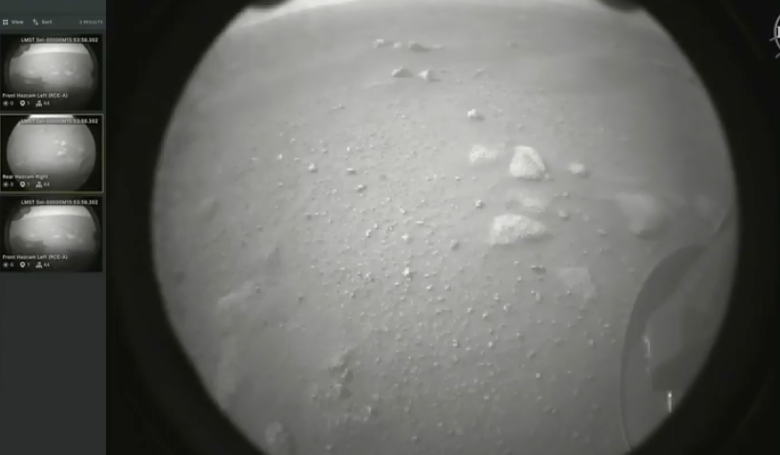Touchdown! It is success for NASA as the agency’s Mars 2020 Perseverance spacecraft – the latest and most complex mission to the Red Planet – lands successfully on Mars after its seven month interplanetary journey.
Perservance hit the atmosphere travelling around 5.4 kilometres per second (km/s), slowing slightly to 5.3 km/s when Mars entry interface was confirmed approximately 120 kilometres from the martian surface. The Mars entry interface "point" is an arbitrary place NASA picked in the martian sky that is around 125 kilometres above the ground and 3522.2 kilometres (about 2,113 miles) from the centre of Mars.
The plummeting craft then employed a number of bank reversals to control its descent and its parachute was deployed around 12 kilometres from the ground.
After radar lock on the ground was established, the perfectly executed descent was followed by a textbook landing as Perseverance touched down intact.
Steve Jurczyk, acting NASA Administrator said of the landing; “It’s amazing to have Perservance join Curiosity on Mars. What a credit to the team. What an amazing team to work through all of the adversity and all the challenges that that goes with landing a rover on Mars, plus the challenges of covid. What an accomplishment.”
Perservance’s descent to the planet was monitored by both NASA’s Deep Space Network and it’s two orbiters; the Mars Reconnaissance Orbiter (MRO) and the Mars Atmospheric and Volatile EvolutioN (MAVEN) orbiter.
However, because the final two minutes of the descent and landing were mostly beyond Mars’ horizon from Earth’s perspective, “direct-to-Earth” X-band communications were impossible, and the rover could only communicate with Earth solely via MRO and MAVEN when it landed.
“It is a huge endeavour to maintain communications with our spacecraft throughout the solar system, but Mars surface missions take this commitment to another level,” said Bradford Arnold, DSN project manager at NASA’s Jet Propulsion Laboratory in Southern California.
The final icing on the cake in detection terms, could from scientists working on NASA's InSight lander who said they might be able to detect the seismic waves generated from the rover landing on Mars from 3452 kilometres away.
With both Perseverance, and Ingenuity – the first small helicopter on Mars – safely ensconced on the martian surface, one of the rovers first activities will be to take pictures of its new home and transmit them back to Earth. A flurry of images were received by JPL ground crew shortly after the craft landed and more expected soon.
During the next four weeks or so, the Perseverance team will start preparing the rover for its task ahead – to search for ancient life on Mars – by installing new flight software and checking on its health.
Meanwhile, the Ingenuity Mars Helicopter team will also be making sure that the first rotorcraft to land on another planet is prepared for its first attempt at a controlled, powered aerodynamic flight across the martian landscape.
Ingenuity is all about demonstrating technology and if it’s flight is a success, then it is likely that more drones will be sent on subsequent missions, not only to Mars but also to Titan, to map the surfaces of these worlds in greater detail than ever before.
Once the mission is ready to get started, how will scientists know if the agency’s newest rover has found fossilised microscopic life on the Red Planet or not?
About the size of a car, the 1,026-kilogram (2,263-pound) robotic geologist and astrobiologist is equipped with a suite of instruments designed to spot potential telltale signs of past microbial life; including SHERLOC (short for Scanning Habitable Environments with Raman & Luminescence for Organics & Chemicals), which can detect organic matter and minerals, and PIXL (short for Planetary Instrument for X-ray Lithochemistry), which maps the chemical composition of rocks and sediments. The instruments will allow scientists to analyse these features together at a higher level of detail than any Mars rover has done before.
“To quote Carl Sagan,” said Gentry Lee, chief engineer for the Planetary Science Directorate at NASA’s Jet Propulsion Laboratory, “If we see a hedgehog staring in the camera, we would know there’s current and certainly ancient life on Mars, but based on our past experiences, such an event is extremely unlikely. Extraordinary claims require extraordinary evidence, and the discovery that life existed elsewhere in the universe would certainly be extraordinary.”
Perseverance is also kitted out with a laser to zap rock and regolith. Called SuperCam the instrument will study the composition of the broken rock and dust by analysing the resulting vapour.
Other instruments will also allow the rover to gather science data from a distance: RIMFAX (short for Radar Imager for Mars’ Subsurface Experiment) will use radar waves to probe geological features underground and Mastcam-Z’s cameras can zoom in on rock textures from as far away as a soccer field.
Perservance will also collect rock core samples in metal tubes, so that future NASA and ESA missions can collect the sealed samples from Mars’ surface and return them to Earth for deeper study.











